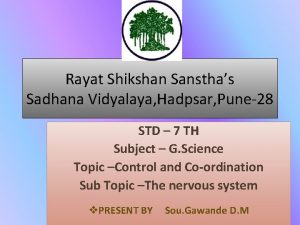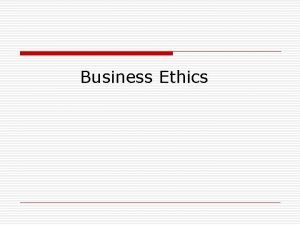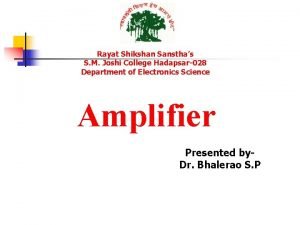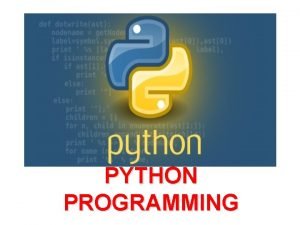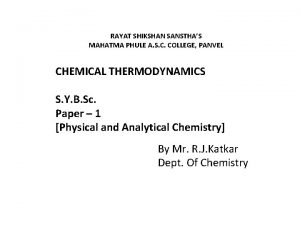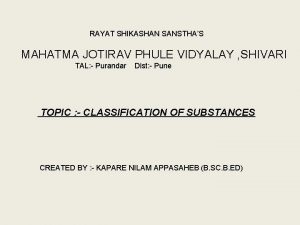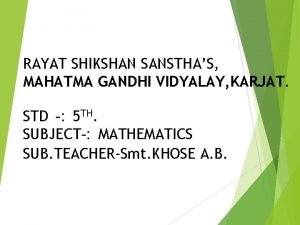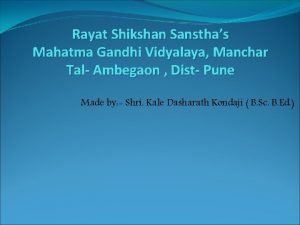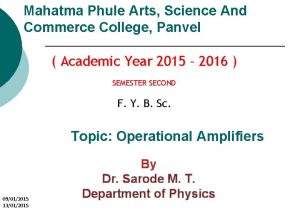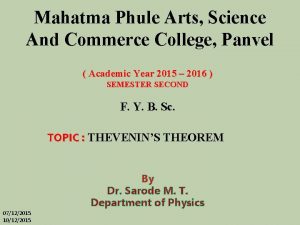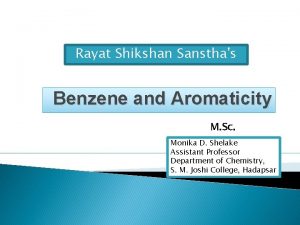Rayat Shikshan Sansthas Mahatma Phule Arts Science and

























- Slides: 25

Rayat Shikshan Sanstha’s Mahatma Phule Arts, Science and Commerce college, Panvel Topic Name: FUNCTIONS Presented by : Prashant K. Patil 1

Functions 2

Definition of Functions • Let A & B be two non-empty sets. Function is a correspondence(map) that assign every element ‘a’ of A, to unique element ‘b’ of B. • Given any sets A, B, a function f from (or “mapping”) A to B (f: A B) is an assignment of exactly one element f(x) B to each element x A. 3

Graphical Representations • Functions can be represented graphically as follows: f a • A f • b B Like Venn diagrams A • • • B • • Graph y x Plot 4

Some Function Terminology If f: A B, and f(a)=b (where a A & b B), then: • • A is the “Domain” of f. B is the “Co-domain” of f. b is the “image” of a under f. a is a “pre-image” of b under f. • In general, b may have more than one pre-image. • The “Range” f(A) with f(A) B is {b | a f(a)=b }. 5

Range vs. Co-domain : Example • Suppose that: “f is a function mapping students in this class say N to the set of grades G={A, B, C, D, E}. ” • At this point, you know codomain of f is: {A, B, C, D, E} _____, and its range is“unknown!” ____. • Suppose the grades turn out all A’s and B’s. {A, B} but its Then the range of f is _____, still {A, B, C, D, E}! codomain is ________. 6

Function Composition q For functions f: A B and g: B C, there is a special operator called compose (“◦”). • It composes (i. e. , creates) a new function out of f, g by applying g to the result of f. • (g ◦ f): A C, where (g ◦ f)(a) = g(f(a)). • Note f(a) B, so g(f(a)) is defined and C. • The range of f must be a subset of domain of g. • Here Domain of g ◦ f = Domain of f and Domain of g ◦ f = Co-domain of g • Note that ◦ (like Cartesian , but unlike +, , ) is noncommuting. (In general, g ◦ f f ◦ g. ) 7

Function Composition 8

Images of Sets under Functions • Given f: A B, and S A, • The image of S under f is simply the set of all images (under f) of the elements of S. f(S) : {f(s) | s S} : {b | s S: f(s)=b}. • Note the range of f can be defined as simply the image (under f) of f’s domain! 9

One-to-One Functions • A function is one-one (1 -1), or injective, or an injection, iff every element of its range has only one pre-image. • Only one element of the domain is mapped to any given one element of the range. ØDomain & range have same cardinality. What about codomain? 10

One-One Functions - cont. . • Formally: given f: A B then “x is injective” : ( x, y: (x y) (f(x) f(y))) or “x is injective” : ( x, y: (f(x)=f(y)) (x =y)) 11

One-One Illustration • Graph representations of functions that are (or not) one-one: • • One-one • • • • Not one-one • • • Not even a function! 12

Sufficient Conditions for 1 -1 ness • Definitions (for functions f over numbers): Let f : ℝ→ℝ be a function then Øf is strictly (or monotonically) increasing iff x>y f(x)>f(y) for all x, y € ℝ ; Øf is strictly (or monotonically) decreasing iff x>y f(x)<f(y) for all x, y € ℝ ; • If f is either strictly increasing or strictly decreasing, then f is one-one. – e. g. f(x)=x 3 13

Onto (Surjective) Functions • A function f: A B is onto or surjective or a surjection iff its range is equal to its codomain ( b B, a A: f(a)=b). • An onto function maps the set A onto (over, covering) the entirety of the set B, not just over some part of it. – e. g. , for domain & codomain R, x 3 is onto, whereas x 2 isn’t. (Why not? ) 14

Illustration of Onto • Some functions that are or are not onto their codomains: • • • Onto (but not 1 -1) • • • Not Onto (or 1 -1) • • Both 1 -1 and onto • • • 1 -1 but not onto 15

Bijections • A function f is a one-to-one correspondence, or a bijection, or reversible, or invertible, iff it is both one-one and onto. 16

Inverse of a Function • For bijections f: A B, there exists an inverse of f, written f 1: B A, which is the unique function such that: 17

Inverse of a function (cont’d) 18

The Identity Function • For any domain A, the identity function I: A A (or, IA, 1, 1 A) is the unique function such that a A: I(a)=a. • Note that the identity function is both one-to -one and onto (bijective). 19

Identity Function Illustrations • The identity function: • • y • • Domain and range x 20

Graphs of Functions • We can represent a function f: A B as a set of ordered pairs {(a, f(a)) | a A}. • Note that a, there is only one pair (a, f(a)). • For functions over numbers, we can represent an ordered pair (x, y) as a point on a plane. A function is then drawn as a curve (set of points) with only one y for each x. 21

Graphs of Functions 22

A Couple of Key Functions • In discrete maths, we frequently use the following functions over real numbers: – x (“floor of x”) is the largest integer x. – x (“ceiling of x”) is the smallest integer x. 23

Visualizing Floor & Ceiling • Real numbers “fall to their floor” or “rise to their ceiling. ” 3. 2. • Note that if x Z, . 1 x x & 0 x x . 1. • Note that if x Z, . 2 x = x. . 3 1. 6 =2 1. 6 =1 1. 4 = 2 3 3 = 3 24

Plots with floor/ceiling: Example • Plot of graph of function f(x) = x/3 : f(x) Set of points (x, f(x)) +2 3 +3 x 2 25
 Rayat shikshan sanstha sadhana vidyalaya hadapsar
Rayat shikshan sanstha sadhana vidyalaya hadapsar Sadhana vidyalaya hadapsar
Sadhana vidyalaya hadapsar Rayat shikshan sanstha kamothe
Rayat shikshan sanstha kamothe Rayat shikshan sanstha sadhana vidyalaya hadapsar
Rayat shikshan sanstha sadhana vidyalaya hadapsar Rayat shikshan sanstha loni
Rayat shikshan sanstha loni Rayat shikshan sanstha motto is
Rayat shikshan sanstha motto is Red rose
Red rose Apollonius theorem
Apollonius theorem Concurant
Concurant Savitribai phule organization
Savitribai phule organization Usha mehta savitribai phule
Usha mehta savitribai phule Creative arts grade 7 term 2 activities
Creative arts grade 7 term 2 activities उद्दीपकाचे
उद्दीपकाचे Profile of mahatma gandhi in english
Profile of mahatma gandhi in english Mahatma gandhi eulogy
Mahatma gandhi eulogy Describe the gandhian philosophy of wealth management
Describe the gandhian philosophy of wealth management Fact file of mahatma gandhi
Fact file of mahatma gandhi Cuando nacio gandhi
Cuando nacio gandhi Cuantos hijos tuvo gandhi
Cuantos hijos tuvo gandhi Mahatma gandhi university library
Mahatma gandhi university library Era il tramonto e ai garruli trastulli
Era il tramonto e ai garruli trastulli Mahatma gandhi young photo
Mahatma gandhi young photo Mahatma gandhi bibliografia
Mahatma gandhi bibliografia Mahatma gandhi short note
Mahatma gandhi short note Mahatma gandhi transformational leader
Mahatma gandhi transformational leader Smjoshi.rayat.dc
Smjoshi.rayat.dc



